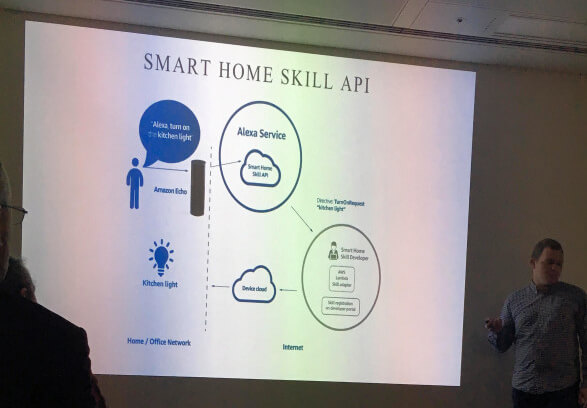Voice technology for the smart home
“The Business of Voice” is the title of one of the sessions hosted last week by CEDIA and Amazon at London’s CodeNode. The event was put on for CEDIA members to understand more about the growth in voice technology in the Smart Home. The sessions looked at how voice technology has developed and how it’s seen as a driver for smart home technology. We also spent a bit of time looking under the hood at Amazon’s Alexa. That involved looking at how Alexa works in the background and the technical architecture that makes it work.
What are we talking about when we’re talking about voice technology?
Let’s take a quick step back. We’re talking here about the voice recognition and processing technology found in devices like Amazon’s Echo, OK Google and Apple’s Siri. There’s a perfect storm occurring in voice technology and the smart home. Investments from the technology giants have co-incided with the growth of hugely scalable cloud technologies. This has created a new opportunity for voice recognition in general and specific smart home applications in particular.

The explosion of voice as a search technology depends on a number of factors. We might sometimes feel we’re on a bit of a technical roundabout that it’s impossible to jump off but that’s not always the case. Consumers don’t always buy what the technology companies push at them. Consumer apathy has pretty well killed off 3D TV. The hardware might still be out there but the content is melting away. If enough people say “this isn’t for me” then technologies wither. All the data presented on this day described a remorseless move to using voice technology for search and other services. That might well be the case but let’s look at what that means.
Dean from Amazon described the challenge of getting from 95% to 99% accuracy. That might seem like a small step but it represents a huge technical challenge. The rewards however make it well worth it. At 99% you’re going to expect your smart device to understand what you want and you’ll be confident asking it. Think back to whichever bit of sci-fi you might have grown up or at least recognise. It doesn’t matter whether it’s Dave Bowman talking to HAL in 2001 or Dave Lister talking to Holly in Red Dwarf they expect to be understood. They might not always get what they want but they do expect to be understood.

If you’re not sure you’re going to be understood you’re going to be more reluctant to ask and that’s why the quest to make that jump from 95% to 99% in voice technology accuracy is so important. Behind the scenes the Alexa architecture is doing a lot of hard work. To be truly smart, it’s not enough simply to recognise what has been said. It’s more important to understand what the speaker actually wants. So different engines within the cloud based architecture are trying to resolve
- What did you actually say?
- What context might you be saying it in – that helps getting through the Four Candles / Fork Handles ambiguities
- What might you mean by what you said, in other words what do you actually want your device to do
Fascinating stuff for the geeks among us but it’s going to have to be totally transparent and accurate if voice technology is going to reach its potential. Look at the scale of the companies involved and you get the feeling it will.
Why does voice technology matter to a lighting company?
Make it natural enough and reliable enough and voice technology is a great way to control lighting (and heating and audio). We’re not advocating ditching keypads at the door and other locations where you’d expect a light switch. We see voice as a great complementary technology. It’s better in many ways than app control which is polarising and at at times simply clunky. Writing this post I found myself asking my Sonos to pause and realising it couldn’t. And feeling a bit miffed I had to fish out my phone to do it. It didn’t take too long living with an Echo for my expectations to be raised. Make it natural, reliable and genuinely useful and they will come.
We’ll continue to follow developments in this area and test them in our own showrooms. If you’d like to know more, give us a call on 01845 525664.


